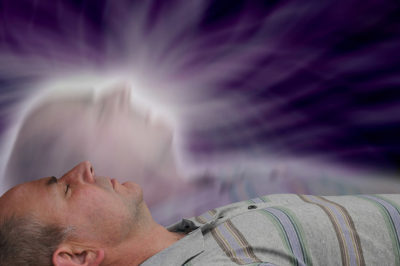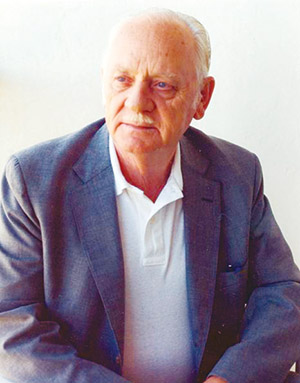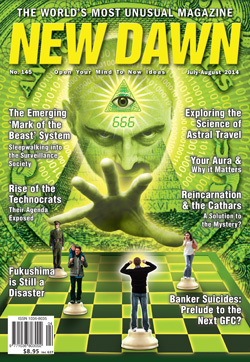From New Dawn 145 (Jul-Aug 2014)
For nearly half a century, Robert Monroe has been the “out-of-body” man, the man who took the subject of astral travel out of the realm of religious or occultist dogma and plopped it right in the middle of mainstream America, and eventually the world.
His books describing his experiences were world-wide best-sellers. But his contribution ranged far beyond writing books. He perfected a technology that made it possible for others to learn to experience altered states at will; invented a stripped-down, de-mystified language to describe these states; and created an institute to conduct residential programs to give people practical experience.
Nineteen years after his death, his influence continues to spread. Odd, then, how little attention people give to his later conclusions. It isn’t that he recanted, but that he reformulated. And that reformulation moves “out-of-body” from curiosity to entry-point.
Bob Monroe
Monroe’s capsule biography would read something like this: Born in 1915 into a middle-class, midwestern American family, he dropped out of college, moved to New York, began writing (and eventually selling) radio scripts, became a producer of successful radio shows, married a couple of times and had a daughter, and, by the time he turned 40, was living the life of the well-to-do businessman in suburban New York, a life that included sailing boats and flying airplanes. Then – as we’ll describe shortly – he began having inexplicable out-of-body experiences which grew in importance to him until they came to dominate the last third of his life.
His first book, Journeys Out of the Body (1971), was his initial, relatively unemotional summary of his experiences. Shortly after the book’s publication, his experiences changed radically, as described in Far Journeys (1985). In the years between the appearance of his first and second books, he began creating ways to help others have the same kinds of experiences. He created Hemi-Sync®, The Monroe Institute, and what we might call Monroe-speak. His third book, his grand summing-up, Ultimate Journey, appeared in 1994, not long before he died on St. Patrick’s Day, 1995. An interesting, successful life. A life that started to become important to the world one Sunday afternoon in 1958, when he was 42 years old.
Out-of-Body Experience
As he describes it in his first book, Journeys Out of the Body, he had lain down for a nap when
…a beam or ray seemed to come out of the sky to the north at about a 30-degree angle from the horizon. It was like being struck by a warm light.… I thought it was sunlight at first, although this was impossible on the north side of the house. The effect when the beam struck my entire body was to cause it to shake violently or ‘vibrate’. I was utterly powerless to move. It was as if I were being held in a vise.
After a few seconds, he forced himself to move, and the vibrations slowly faded.
(Oddly enough, few people who write about Monroe’s experiences seem to have noticed this beam that “seemed to come out of the sky.” We will come back to it.)
That was not an out-of-body experience, but it was the beginning. Although the beam was a one-time thing, the vibrations and the temporary paralysis happened nine more times in the following six weeks. He had a physician friend examine him for physical or mental abnormalities, but the doctor merely suggested he had been working too hard, which was reassuring, but not helpful. If this phenomenon was not a symptom of something going wrong, what was it?
Remember, this was the 1950s. The concept – the very terminology – of out-of-body travel was unknown to mainstream culture. As he put it in Far Journeys, his early investigations took him
…beyond conventional scientific circles (total rejection), religions (‘It’s the work of the devil’), parapsychology (‘Interesting. Sorry, no data available’), and Eastern disciplines (‘Come study at our ashram in northern India for ten years’).
He was on his own. So far as he knew, nobody else had ever experienced what he was going through. But he was stubborn, in his quiet way. As time went on and the experiences persisted, and then deepened, so did his desire to understand what it all meant. He said later that it took a full year and 40 trips out-of-body before he accepted the reality of out-of-body experience.
So what was he going through?
Monroe, in Far Journeys, defined an out-of-body experience as
…a condition where you find yourself outside of your physical body, fully conscious and able to perceive and act as if you were functioning physically – with several exceptions. You can move through space (and time?) slowly or apparently beyond the speed of light. You can observe, participate in events, make wilful decisions based upon what you perceive and do. You can move through physical matter such as walls, steel plates, concrete, earth, oceans, air, even atomic radiation without effort or effect. You can go into an adjoining room without bothering to open the door. You can visit a friend three thousand miles away. You can explore the moon, the solar system, and the galaxy if these interest you. Or – you can enter other reality systems only dimly perceived and theorised by our time/space consciousness.
But by the time he wrote that he had been doing it for many years. For a long time, all he knew was that he could somehow detach from his physical body, and roam around his bedroom, or around the house or even the neighbourhood. After a while he found that he could think himself elsewhere, apparently regardless of distance. He made some experiments to verify or disprove what he was perceiving, but, as he wrote, after a while such experiments became oddly boring.
(By the way, it is a common assumption that out-of-body exploration naturally leads to voyeurism, but this mistakes the nature of the experience, which is less like watching a movie than like vivid imagination. The word “imagination” can be misleading: In this case it refers not to fantasy, but to what might be called imagination as a tool of perception.)
Locale II
In retrospect, until Journeys Out of the Body was published Monroe’s life had only begun moving into uncharted waters. So that first book’s descriptions are not his last word. For instance, he separated his experiences into Locale I, II, and III. Locale I was physical reality, as we experience it. The realm he called Locale III, I’m not going to discuss here, because I think he came to see this earlier idea as misleading, and the later books make no mention of it.
Let’s concentrate on Locale II. He called it the natural home of the second body – the part of ourselves that could journey beyond the physical. That body, he said, was very responsive to Locale II, where apparently thought powers everything. He concluded that those who had once lived in the physical world had created what he experienced as solid matter in Locale II, either automatically (because they still thought that way) or deliberately (for pleasure or comfort). Such simulations, he concluded, were also created by higher beings for the benefit of those just emerging from the physical world.
Locale II was inhabited “by entities with various degrees of intelligence with whom communication is possible.” Monroe said that, “In this vastness lie all of the aspects we attribute to heaven and hell.” And, during these early excursions, he began to learn how to contact the dead, a development that would grow to great importance.
But if Locale II was real, where was it, and how was it that we could contact it? In Journeys Out of the Body he gave us the key: He said his theory depended on
the wave-vibration concept, which presumes the existence of an infinity of worlds all operating at different frequencies, one of which is this physical world. Just as various wave frequencies in the electromagnetic spectrum can simultaneously occupy space, with a minimum of interaction, so might the world or worlds of Locale II be interspersed in our physical-matter world. Except for rare or unusual conditions, our ‘natural’ senses and our instruments which are extensions thereof are completely unable to perceive and report this potential. If we consider this premise, the ‘where’ is answered neatly. ‘Where’ is ‘here’.
In other words, our experience is determined by what we tune into. If our receiver is set only to the here-and-now world, that’s all we will receive. If, accidentally or by training, we start picking up other wave-lengths, we are going to be living at least to some extent in a different world. Something shifted the knob on Monroe’s tuner, and he began to pick up other programs, and then he learned to shift the knob himself. That is the basis of all that followed.
Meanwhile he was moving from being a lone explorer into an organiser of expeditions, on two fronts. First came the ‘Explorers’, then the ‘Gateway Voyages’ and other residential programs.
Beyond the Personal
Journeys Out of the Body, published in 1971, brought him thousands of letters, including “many hundreds” from people writing to thank him for assurance they weren’t crazy. By the time he published Far Journeys in 1985, he was no longer working on his own. He had begun to create what became The Monroe Institute (TMI), he had put together Explorer teams, he had invented the Hemi-Sync technique, and he had begun offering the Gateway program, teaching others to do what the culture at large still didn’t dream possible.
I often say Monroe gave the world three gifts: a technology, a language, and an environment.
The technology was hemispheric synchronisation, or Hemi-Sync. Simply put, this consisted of feeding sound of one frequency into one ear, and sound of a somewhat different frequency into the other ear. This forced the two halves of the brain to work together to make sense of the input; it also allowed him to input specific combinations of frequencies to facilitate desired brain states, and hence, it was hoped, mental states. Thousands of hours of experimentation discovered certain particularly useful combinations, which he noted and named.
And that nomenclature was the second of his gifts, a value-neutral language to use to describe various mental states, so that they could be examined and employed with fewer emotional overtones. He numbered them as Focus 3, 10, 12, 15, and 21 through 27. This stripped-down language became a means of structuring and re-thinking the experience, and quickly became familiar not only to the explorers with whom he discovered and developed them, but to participants in the residential programs he developed.
These residential programs, with the institute supporting them, are the third part of his legacy, a supportive environment combining individual experience of the various focus levels with group debriefings and interpersonal discussion. Taken together, the three tools helped thousands of people to carry on Monroe’s explorations in their own way, finding their own answers to their own questions. (“I don’t know,” he used to respond when asked to define things. “You go find out and come back and tell me and then we’ll both know.”) But before the residential programs came the Explorers.
Explorers, Gateway & Beyond
Before there was an institute, there was a group of unpaid volunteers, drawn by curiosity. Lying on a waterbed in a darkened, silenced room, wired to instruments that were monitored during the entire experience, they received Hemi-Sync signals and other communications from their monitor through headsets, and could speak to the monitor (and a tape recorder) through a microphone.
In order to help them get into a borderland sleep state, Monroe employed the Frequency Following Response he had discovered. “We could tell easily from the instrument readout when they were and when they were not in Focus 10. It could not be imagined or faked…” Then he inserted higher-frequency beta signals to “enhance perceiving by means other than the five physical senses,” and the subjects began to experience light and colour patterns, voices and music, and “sometimes loud explosions that startled the subject completely out of Focus 10 – something that has still to be explained.”
Monroe described in Far Journeys how one Explorer, having “developed a very close relationship with what appeared to be some four or five beings, one of whom acted as spokesman,” allowed them to experiment in using her body as a sort of “transmitting set between dimensions.” She let them experiment with talking through her vocal cords, which, after a lapse of about three and a half minutes, they did. And this was the beginning of acquisition of a vast amount of material, from her and from others. As he put it, “the Explorer Material is a combination of fascinating, baffling, awe-inspiring, thought-provoking, sometimes boring data that is certainly much in conflict with many of the belief systems that we have within our culture and civilisation.”
The Gateway program, initially weekend programs held “at motels, conference centres, and special meeting facilities throughout the United States,” developed into a residential course given from Saturday afternoon to Friday morning at TMI, half an hour south of Charlottesville, Virginia. The program was carefully designed to lead people from normal C1 consciousness to other, less usual, states. It’s all done a little at a time, and the net effect is to dissolve what Monroe called the Fear Barrier and unleash the formidable power of individual curiosity. In Gateway, many people learn for the first time by personal experience that they are more than their physical body.
Over the years, additional programs were developed, a process that continues today. By my rough count, the Institute currently offers nearly two dozen programs of one kind or another. All use Hemi-Sync or the newly developed Spatial Angle Modulation (SAM) technology, and, in all cases, the group energy is an important part of the process, as it combines irreplaceable first-hand experience with nearly equally valuable second-hand reports of other people’s experience of the same exercise at the same time.
Later Views
The biggest changes in Monroe’s life after publication of Journeys Out of the Body were in the nature of his journeys. In 1972 he told himself that rather than his conscious self, his ego, determining what to do while he was out-of-body, “the decision to do is to be made by my entire self.” As he put it, “The presumption I made was that my Greater Self (soul?) always knew what it was doing.” And this brought him from local traffic onto the Interstate – the open highway. From this point on his reports centre on the Second State, the reality beyond the world our senses report, which he had initially described as Locale II.
In Ultimate Journey he says the Institute, “moved away from seeking materialistic explanations to look at the other end of the spectrum.” They discovered that much of what appeared to him to be out-of-body activity had been explained away as dream activity.
Most important, the mind-consciousness present in the out-of-body state is significantly different from that in physical wakefulness. Initially, intellectual and analytical focus do not seem to be present, at least not in terms we understand. However, the insertion of physical consciousness changes this. Conversely, the emotional extremes of the symbolic right brain are often totally absent and are usually more difficult to activate.
As always, Monroe defines a Belief – as opposed to a Known – as anything that cannot be fully understood or identified.
So it must be said: the Different Overview you are beginning to consider can at most be a belief until you begin to test it for validity within your own ongoing experience during your life as an active Human Mind. As small beliefs convert to Knowns, perhaps larger Different Overview beliefs will follow the same path – until you are free.
What Does it Mean?
Monroe’s life is almost a textbook case of a man following where he was led, not dreaming that what seemed simply a personal preoccupation would broaden and meet response and lead his life in an entirely unanticipated direction. He let his total Self drive and open up his life unimaginably. His ideas changed. By the end of his life he was no longer talking about going “out-of-body”; instead he would talk of moving “out-of-phase.” Remember his description of many frequencies operating in the same space, overlapping but not interfering? Remember the analogy of changing the tuning on our radio receiver? By the end of his life, he had concluded that this is what he had been doing. He hadn’t gone “out-of-body” in the sense of leaving an empty shell behind; he had changed his focus of attention – had gone “out-of-phase” with the physical – and then had gotten back into phase to report, and carry on his life.
Oh, and remember the beam that “seemed to come out of the sky,” which started it all? Years later, I asked my own guidance about it, and was told that right from the beginning Monroe was being put on notice that this was not a strictly material manifestation; that the beam was not necessary to produce the effects, but it did serve to loosen his mental bonds. Perhaps so. That still leaves more questions unanswered than answered, but that seems to be the nature of life.
From “out-of-body” to “out-of-phase” is a long step, and a productive one. When you realise we are more than our physical bodies; that our consciousness inhabits many worlds at once; that it isn’t a question of leaving your body vacant but of redirecting your attention, you begin to understand that learning to go out-of-body is not the goal, but the doorway.
© New Dawn Magazine and the respective author.
For our reproduction notice, click here.




